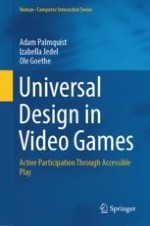2024 | OriginalPaper | Chapter
3. Design Implications and Processes for an Attainable Game Experience
Authors : Adam Palmquist, Izabella Jedel, Ole Goethe
Published in: Universal Design in Video Games
Publisher: Springer International Publishing
Activate our intelligent search to find suitable subject content or patents.
Select sections of text to find matching patents with Artificial Intelligence. powered by
Select sections of text to find additional relevant content using AI-assisted search. powered by

